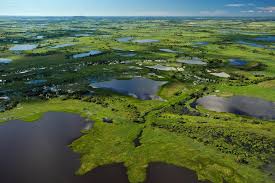Pantanal Wetland:

Fires in Brazil’s Pantanal wetlands have surged nearly tenfold so far this year to the highest levels since 2020.
- Pantanal Wetland is the world’s largest tropical wetland.
- It is located in the upper Paraguay River basin, the Pantanal straddles Brazil’s border with Bolivia and Paraguay.
- About 80 percent of the Pantanal is in Brazil.
- It’s a 185,000-square-kilometer (71,000-square-mile) mosaic of grassland swamps fed by rivers, streams and seasonal floods and dense, low-forested savanna.
- It was developed in a structural basin formed as the Andes Mountains rose.
- The climate is tropical, wet and dry.
- It is one of the most biologically rich environments on the planet, with more than 4,700 plant and animal species.
- Noteworthy animals include the jaguar, giant otter, giant armadillo, marsh deer, pampas deer and hyacinth macaw (the biggest parrot on the planet).
- It has the largest concentration of crocodiles in the world, with approximately 10 million caimans.
- In 2000, the United Nations Educational, Scientific, and Cultural Organization (UNESCO) declared a small portion of the Pantanal a World Heritage Site.
- Around 95% of the Pantanal is under private ownership, the majority of which is used for cattle grazing.




